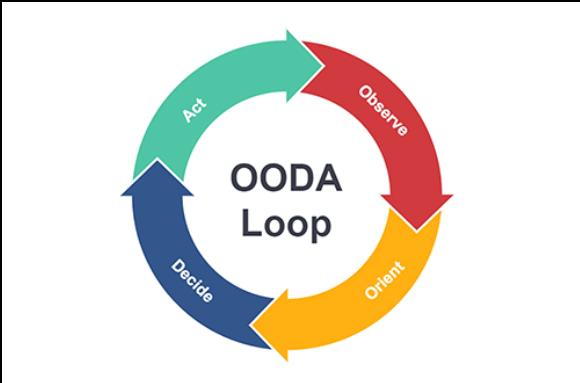
Understanding the OODA Loop: A Comprehensive Guide for Effective Decision Making
The OODA loop (Observe, Orient, Decide, Act) is a decision-making framework that has been widely used in various fields, from military operations to business strategy. Developed by military strategist and USAF Colonel John Boyd, the OODA loop provides a structured and systematic approach to decision-making in complex and rapidly changing fields and environments.
This article will provide a comprehensive guide to understanding and applying the OODA loop to improve your decision-making process.
Observe
The first step in the OODA loop is to observe the situation or environment. This involves gathering information about the current state of affairs, including the people, processes, and systems relevant to your decision.
It is important to be aware of any patterns or trends that may impact your decision. This could be through direct observation, such as taking inquiries, asking questions, observing trends, or indirectly, through data analysis and research.
Orient
The next step in the OODA loop is to orient yourself to the situation. This involves reading and researching related evidence, understanding the context of the problem, and considering how it aligns with the goals and values set in the first phase.
You should also consider any relevant knowledge, experiences, and biases that may impact your decision. This step is crucial in avoiding tunnel vision and ensuring that you completely understand the situation before making a decision.
Decide
Once you have observed and oriented yourself to the situation, the next step is to make a decision. This involves evaluating the different options available to you and selecting the best course of action based on the information you have gathered and your understanding of the situation.
In making a decision, it is crucial to consider both short-term tactical and long-term strategic consequences, as well as any potential risks and uncertainties.
Act
The final step in the OODA loop is to act on your decision. This involves putting your plan into action and monitoring its effectiveness.
It is essential to be flexible and willing to adjust your approach if circumstances change or if your decision proves to be ineffective. The OODA loop is not a one-time process but a continuous cycle that allows you to evaluate and improve your decision-making process continually.
The Benefits of the OODA Loop in Healthcare
The OODA loop provides a structured and systematic approach to healthcare decision-making, which can improve the speed and quality of decisions. By following the OODA loop, healthcare professionals can ensure that they have considered all relevant information and that their decisions are aligned with the patient’s goals and values.
The OODA loop also allows healthcare professionals to continuously evaluate and improve their decision-making process, which can help them stay ahead in a rapidly changing healthcare environment.
How do we use OODA LOOP in chiropractic?
The Observation phase:
The first step in our clinical approach is to gather relevant information about your medical condition, injury, and overall health. This is known as the Observation phase. During this phase, we will conduct an in-depth analysis of your health history, including your current and past injury or illness and medical history. Then, we will thoroughly examine the affected region and the problem. Our examination process will focus on gathering subjective and objective information that will help us better understand your problem, injury, or illness.
The Orientation Phase:
In the Orientation phase, we will have comprehensive discussions about the findings from the previous phase. We will take our time to evaluate the diagnoses, prognoses, and available treatment options. Additionally, we will consider the need for referrals, co-management, or further diagnostic testing if necessary. Our action plan or treatment plan will be based on your goals, such as reducing pain or improving a specific activity or function. Our goal is to help you understand what is going on and the expected outcome of our treatment plan. During this phase, we will also discuss the cost of treatment options, including pharmaceuticals (drugs) and surgery, and the pros and cons of each.
The Decide Phase:
In the Decide phase, our healthcare team will help you make an informed decision about your health and goals. We will provide you with a treatment plan and schedule for periodic reevaluations of your condition and our approach. Upon your consent to treatment, we will proceed to the next phase, the Action Phase.
The Action Phase:
The Action phase is where we will start your personalized treatment plan. Our team will regularly reevaluate the treatment outcome and your condition, typically every five visits or after one month, whichever comes sooner. Based on our reobservation, reevaluation, changes, and new information, we may modify the treatment plan as needed.
Our clinical approach is designed to help you make an informed decision about your health and goals. With a focus on observation, orientation, decide, and action, our team is dedicated to providing you with personalized, high-quality care.
Conclusion
The OODA loop is a valuable tool for effective healthcare decision-making in complex and rapidly changing environments. By observing, orienting, deciding, and acting, healthcare professionals can improve the speed and quality of their decisions and provide the best possible care for their patients.
We hope this article has provided you with a comprehensive understanding of the OODA loop and how you can apply it to improve your decision-making process.
